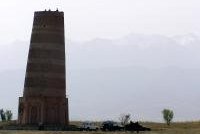Solivagant 3.0
Silk Roads: Chang'an-Tianshan Corridor
Silk Roads: Chang'an-Tianshan Corridor (Inscribed)

Perusing the list of 33 sites included in this nomination one starts in the East with reasonably well known ones in Xian – the Wild Goose Pagodas and then on through 2 existing WHS at Longmen and Mogao and finally into the Tienshan area itself after which this part of the Silk Route has been named. And there is one in this group which I recognised – Burana in Kyrgyzstan!
We visited this site back in 2004. It is situated around 70kms east of the capital Bishkek on the road to Lake Issyk Kul. Now. Kyrgyzstan is a place to visit primarily for its mountains and (at least in those days) the remains of its nomadic traditions – one highlight of our visit was to hear a Manaschi chanting the world’s longest epic poem (not the whole thing luckily as it extends to half a million lines!). Major historical sites are not the country’s strong point. Burana was a “stop off” visit therefore as much to break the morning’s drive to Issyk Kul as to see anything “remarkable”.
And, in all honesty, what is on show isn’t that great – the stubby remains of a once much taller minaret now called the “Burana Tower” set against an attractive mountain background (photo). Constructed in brick, it has been heavily restored even at its reduced height. I was interested to note that the AB evaluation states “Minor repairs on the minaret at Burana were carried out in the 1970s using cement. The local authorities are now working to research appropriate repair materials similar to the originals in order to reverse this work”. Apart from a few mounds, this is about all that remains above ground of “the city of Balasagun (Site of Burana), the capital of the Eastern Kaganate of the Islamic Turkic state, is a planned Islamic medieval city of the 10th -14th century with a 24metre high minaret.” (AB). The AB also states that any excavations of the city itself have been back filled and certainly when we were there we gained no feeling for what else had been there beyond the ruined minaret. My memory of other extant remains is solely of a rather nice collection of “Balbals” – Kyrgyz anthropomorphic grave markers. Although the AB reports that there is an on-site museum and a good range of information boards, none of these were present in 2004. We climbed the tower through its spiral interior staircase and enjoyed the view of the mountains and the agriculture in this fertile valley and then made off to meet and talk to some Kyrgyz farmers who were wearing their attractive felt hats – and that was it! But with WHS you can never be sure. Who would have thought that, 10 years later, this site would have been deemed to possess OUV.
As the original T List entry for this site will be replaced on the UNESCO Web pages once the site is inscribed it might be worth commenting on the differences between it and the sites in Kyrgyzstan reviewed by ICOMOS as part of the Tien Shan Silk Road”. The T List contains 6 groups of sites. One, titled “Nomadic Monuments of Inner Tien Shan”, contains Tash Rabat reviewed by Jorge Sanchez below, together with Koshoi- Korgon, Manakeldy, Shyrdakbek and Kochkor. Others are “Sites of the Southern Issyk Kul” (Barskoon), “Medieval sites in the Upper Chui Valley: Navikat (Krasnaya Rechka), Suyab (Ak Beshim) and Balasagyn (Burana)”, “Cultural Environment of Manas Ordo” (the mausoleum thought to contain the remains of the Kyrgyz hero Manas – about whom the Manaschi sing), “Cultural Landscape of Safid Bulan” (Shakh Fazil mausoleum) and “Uzgen and Shorobashat sites”. But, from all of these, only 3 sites of the Upper Chui Valley have made it to the final nomination – obviously the others were not considered relevant for a “Silk Road” site. It will be interesting to see if Kyrgyzstan puts the others back into a new T List entry on a different basis.
Comments
No comments yet.
